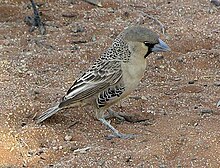Sociable weaver
| Sociable Weaver | |
|---|---|

| |
| in Etosha National Park, Namibia | |
| Scientific classification | |
| Kingdom: | |
| Phylum: | |
| Class: | |
| Order: | |
| Family: | |
| Genus: | Philetairus
|
| Species: | P. socius
|
| Binomial name | |
| Philetairus socius (Latham, 1790)
| |
The Sociable Weaver or Social Weaver (Philetairus socius) is a species of bird in the Ploceidae family. It is monotypic within the genus Philetairus. It is found in Botswana, Namibia, and South Africa.

Behaviour
Diet
The sociable weaver is insectivorous. As an adaptation to living in the dry Kalahari Desert, where standing water is scarce, the sociable weaver obtains all of its water from a diet of insects.
Nesting

Sociable weavers construct permanent nests on trees and other tall objects. These nests are large enough to house dozens of families of birds, containing several generations at a time. The nests are highly structured and provide birds with a more advantageous temperature relative to the outside. The central chambers retain heat and are used for nighttime roosting. The outer rooms are used for daytime shade. Sociable weaver nests are used commensally by several other bird species, most commonly the Pygmy Falcon.
Breeding
In the southern range of the weaver's habitat, breeding is triggered by rainfall [1]. Under typical conditions, weavers raise up to four broods per breeding cycle. Sociable weavers are known to assist in the care of younger siblings and unrelated hatchlings. A mating pair has been recorded as producing nine broods in a single season in response to repeated predation of its young.
References
- ^ University of Cape Town
- BirdLife International 2004. Philetairus socius. 2006 IUCN Red List of Threatened Species. Downloaded on 26 July 2007.
- University of Cape Town. [[1]]
- San Diego Zoo. [2]
- International Wildlife. [3]
Video
- Sociable Weaver videos on the Internet Bird Collection

